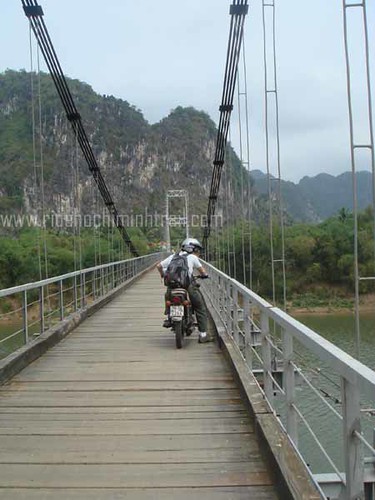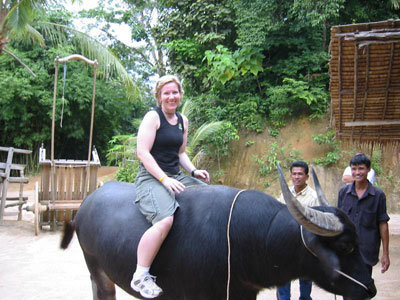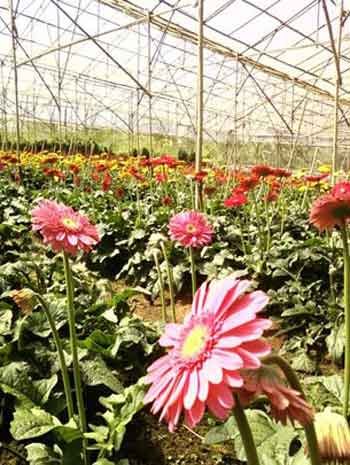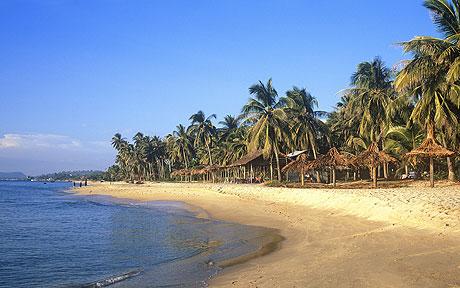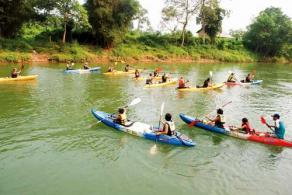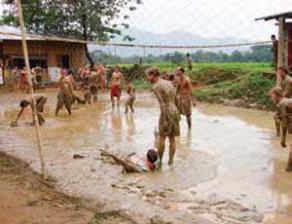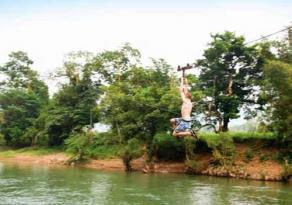Modern Vietnam has many attractions, says Tim Jepson, but one event from its recent past still looms above all others.
Don't mention the war. This, more or less, is the gist of my Rough Guide to Vietnam. Or, more accurately – and I'm paraphrasing here – don't become obsessed by the war. But it's hard when visiting a country where the association, for me at least, is immediate and inescapable: Vietnam – war.
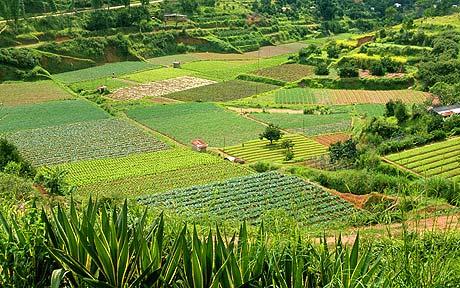
Countryside in Dalat, Vietnam - Photo by Getty
The closeness of the real world must have been the strangest thing, I think, as I sit reading the guide and looking down on miles of jungle during my flight from Bangkok to Ho Chi Minh City, better known by its former name, Saigon. It's just an hour from the Thai capital to a city synonymous with war: just an hour for all those GIs between fighting and the various pleasures afforded by a few days' leave in Bangkok.
Returning to who knows what, doubtless in far less comfort, they would have looked down on the same landscape: the jungle-covered hills, the numerous tiny villages, the sudden, sprawling urban scar of Phnom Penh, and then the majestic, churning waters of the Saigon and Mekong rivers, sweeping in vast brown meanders through emerald paddy fields.
As we come in to land, it's impossible not to note that Saigon's airport was obviously once much larger – the outlines of buildings long gone are still clear from the air. Nor to ignore the rows and rows of bunkers once used to shelter assault helicopters, their ageing concrete, for now, resistant to the effects of time and tropical weather. In this part of Vietnam, the war is right there, right from the start.
Impossible, too, not to notice the victors' symbol, the red flag and hammer and sickle – not an image one often sees these days – adorning the airport and most of the streets and larger public buildings as we drive through Saigon.
And so to hot, humid Saigon itself, a place that manages to be modern and moribund at the same time. I know you shouldn't judge a place solely on its sights, but the city, as far as I can make out, has just two things to see: the swarms of motorcycles, weaving and jostling on every street as if in some exhaust-filled ballet; and Vietnam's most popular tourist "attraction" – the War Remnants Museum.
The latter is a nasty, graceless old-fashioned sort of museum, housed in a bleak, crumbling Eastern Bloc-style building and a few ramshackle Fifties huts around a courtyard full of hawkers, beggars, tanks, bombs, howitzers, a US helicopter and other twisted-metal memorials to the events of 35 years ago.
Nasty and graceless, but utterly compelling. Especially the helicopter, of a sort you've seen in all those war movies. Its interior is virtually bare, utterly stripped down to basics, its battered, dirty, spartan appearance strangely, eerily redolent of combat. For some reason, I've assumed the equipment of war would somehow be polished, pristine, hi-tech. It very much isn't, at least once it's seen combat. The helicopter interior powerfully evokes the utilitarian grime of war in a way I've never encountered. The battered, scratched and dented rifles and other guns elsewhere in the museum have the same effect. Written down, these are platitudes, but the effect on the spot is revelatory.
There's more, of course, all worse, if anything (the guillotine used by the French, the instruments of torture used by the South Vietnamese, the deformed foetuses almost certainly caused by Agent Orange), and somehow it's all the more harrowing because of the ramshackle setting.
It's also the victors' museum, of course, and skewed in their favour, but the Americans looking around with me – and there are many of them – are talkative and engaged. The equally large number of elderly Vietnamese men, by contrast, are silent and inscrutable. You can't help but wonder: where were they and what they were doing 40 years ago?
Give Saigon a day or so. Stay in the wonderful Grand Hyatt, maybe visit the famous Cu Chi tunnels (where the Viet Cong – incredible this – hid for years just 15 miles from the centre of the city); see the markets (Ben Thanh especially); climb the Jade Emperor Pagoda; take on the mopeds at road junctions. And eat the fantastic food – the French, who contributed so much to the mess of the Fifties and Sixties, at least left a gastronomic legacy.
Then do as we do, and as the Rough Guide implores – forget the war and head out, being sure to avoid the usual dash from Saigon to Hanoi, or vice versa, preferred by most visitors.
The Vietnamese government, belatedly, and still half-heartedly, awakening to the possibilities of moneyed tourism, is keen for you to visit Da Lat, a 40-minute hop by plane from Saigon. We obliged, helped by the presence of the
Ana Mandara Villas, among the first of only a handful of upmarket resorts in Vietnam (but surely, if – as everyone tells you – Vietnam is like Thailand was 15 or 20 years ago, not the last).
A hill station pioneered by the French in the early 20th century, Da Lat largely escaped the war; a town so pretty the US and North Vietnamese tacitly agreed not to bomb it. But that was then. Even in the Fifties, travel writer Norman Lewis found parts turning into a "drab little resort", and Lewis is the kind of writer who was invariably right. Today, the town's popularity with Vietnamese visitors, honeymooners in particular, has rendered it largely a mixture of kitsch and concrete.
But there are compensations. The Ana Mandara resort, for one, built around a series of French colonial villas saved from the Communists' progress-is-all wrecking ball. Perfect in every period detail, it makes a cosseted and tucked-away base for forays into the surrounding mountains, which are superb, and where you can hike or make fascinating visits to the villages of the area's minority peoples.
Vietnam has 52 ethnic minority groups, many of them splintered into hundreds of much smaller groups – 11 million people in all out of a population of 82 million. Many are mysterious of origin, semi-nomadic and highly resistant to the attempts of successive rulers to tame them – even the current Communist government. Many mountain areas have been off-limits to visitors in the past two or three years as the Vietnamese army – in an ironic echo of the war it fought and won against the Americans – struggles, unsuccessfully it appears, to quell the guerrilla uprisings of disgruntled and intransigent mountain "rebels".
Trips to these villages alone, however, would probably not have made the detour to Da Lat worthwhile. What did was the spectacular new road (built for those hoped-for new visitors) from Da Lat through the mountains to the coast. It's a glorious drive, offering a window onto some of the country's most dramatic scenery, from soaring crags and mist-shrouded jungle, still home to tigers, to the gentler hills and fertile lowlands close to the coastal town of Nha Trang.
Nha Trang is another place for which the government has high hopes, and here they're on to a far better thing – as is Six Senses, former owners of Ana Mandara, which has opened a second and, for me, more enticing resort, the Six Senses Hideaway at Ninh Van Bay, sequestered on a pristine cove well away from the town.
This really is a hideaway, built on a crescent of white sand framed by steep, jungle-covered mountains, its combination of stylish beach, hill and water villas reached only by boat. Six Senses' mantra is "intelligent luxury", exemplified here by the clever use of wood, stone bamboo and the exemplary rendering my "four-S" requirement of a resort: Sea, Sand, Setting and Service.
The last is wonderful: the Vietnamese really are an exquisite people, exemplified by the young women who take us around the resort on bicycles. Charming and friendly, they are proud and happy as they tell us how they have just passed their English exams.
For much of my stay, I am prone, but lever myself up to visit Nha Trang, a spotless, trim resort town with an extraordinary four-mile beach and a wonderful palm-lined promenade that (seriously) puts Nice to shame. The sand and waterfront are immaculate and busy – but not too busy – with locals and Vietnamese visitors. If this is the new Vietnam, and the one the regime wants us to see, then I'm all for it.
Even so, it is still nice to return to the sanctuary of our resort, and the soft beauty of sand and jungle. The war seems a long way away here, the smiling young staff the bright embodiment of a new generation; the baby boomers of their particular war. And it should seem distant, of course, for it was 35 years ago.
But as I walk from the restaurant one evening along the sandy trails cut through the jungle, I can't help but imagine a US soldier walking this same, silent path. Here, the jungle has been thinned, the paths cleared. Yet in the gloom, even in this manicured enclave, I can barely see a few feet into the undergrowth. Suddenly everything seems eerie, ominous: 35 years ago, anything, or anyone, could have been concealed, watching, waiting, tracking, trailing.
As in the war museum, the moment is revelatory. It makes me realise with sudden clarity the futility of the whole US venture in Vietnam. An American soldier would have had little chance here; at the mercy of an opponent completely at home in this environment. A child could have walked down this path and told the US generals their project was doomed.
An odd thought, I admit, after a sumptuous dinner, with the creamy comforts of a luxury villa waiting farther down the beach. But Vietnam does that. Vietnam – war. It's a tough link to break.
Source: Tim Jepson/telegraph.co.uk
Related sites
- Vietnam Travel Guide
- Short Excursions in Vietnam
- Adventure tours in Vietnam
